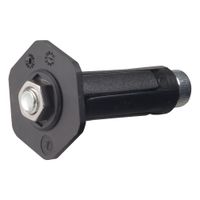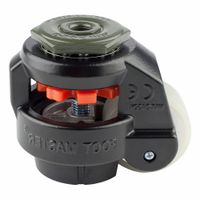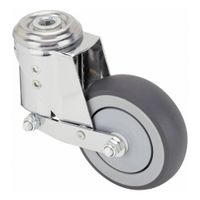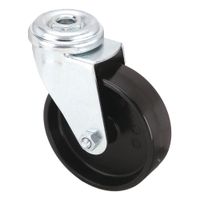Call +(254) 703 030 000 / 751 483 999 / 721 704 777
- Home
- Material Handling
- Casters Wheels
- Bolt Hole Casters
.....Read More
Frequently Asked Questions
What are bolt-hole casters used for?
Bolt-hole casters are used to provide mobility and support to various types of equipment and furniture. They are designed to be attached to the bottom of objects through a bolt-hole, which is a pre-drilled hole in the caster's mounting plate. This allows for secure attachment and easy installation. Bolt-hole casters are commonly used in industrial, commercial, and residential settings for a variety of applications.
In industrial environments, bolt-hole casters are often used on machinery, carts, and workbenches to facilitate easy movement and repositioning. This is particularly useful in manufacturing and warehouse settings where equipment needs to be frequently relocated or adjusted.
In commercial settings, bolt-hole casters are found on items such as retail displays, office furniture, and medical equipment. They enable smooth and efficient movement, which is essential for cleaning, rearranging spaces, or accessing different areas quickly.
In residential settings, bolt-hole casters are used on furniture like chairs, tables, and storage units. They provide the flexibility to easily move furniture for cleaning, rearranging, or optimizing space usage.
Bolt-hole casters come in various sizes, materials, and load capacities to suit different needs. They can be made from materials like rubber, polyurethane, or metal, each offering different levels of durability, noise reduction, and floor protection. Some bolt-hole casters also feature locking mechanisms to secure the equipment in place once it has been moved to the desired location.
Overall, bolt-hole casters are essential components for enhancing the mobility and functionality of various objects, making them easier to handle and more versatile in different environments.
How do you install bolt-hole casters?
To install bolt-hole casters, follow these steps:
1. **Select the Right Casters**: Choose casters that match the weight capacity and size requirements of your furniture or equipment. Ensure the bolt-hole size matches the bolts you plan to use.
2. **Gather Tools and Materials**: You will need a drill, drill bits, bolts, nuts, washers, a wrench, and a measuring tape.
3. **Prepare the Surface**: Turn the furniture or equipment upside down to access the bottom. Clean the surface to ensure proper installation.
4. **Mark the Drilling Points**: Use the caster's bolt-hole as a template. Place the caster at the desired location and mark the center of the bolt-hole on the furniture with a pencil.
5. **Drill Holes**: Select a drill bit that matches the diameter of the bolts. Drill holes at the marked points. Ensure the holes are straight and deep enough to accommodate the bolts.
6. **Attach the Casters**: Align the caster's bolt-hole with the drilled hole. Insert the bolt through the caster and into the hole. Place a washer on the bolt before securing it with a nut.
7. **Tighten the Bolts**: Use a wrench to tighten the nuts securely. Ensure the caster is firmly attached and does not wobble.
8. **Repeat for All Casters**: Install all casters in the same manner, ensuring they are evenly spaced and aligned.
9. **Test the Installation**: Turn the furniture or equipment upright and test the movement. Ensure the casters roll smoothly and are securely attached.
10. **Make Adjustments if Necessary**: If any caster is loose or misaligned, make the necessary adjustments to ensure stability and functionality.
What materials are bolt-hole casters made from?
Bolt-hole casters are typically made from a variety of materials, each chosen for specific properties that suit different applications. Common materials include:
1. **Steel**: Known for its strength and durability, steel is often used for the caster frame and wheel core. It is ideal for heavy-duty applications where high load capacity is required.
2. **Stainless Steel**: Offers corrosion resistance, making it suitable for environments exposed to moisture or chemicals, such as food processing or medical facilities.
3. **Aluminum**: Lightweight and resistant to corrosion, aluminum is used for casters that need to be both strong and easy to maneuver.
4. **Plastic**: Various plastics like nylon, polypropylene, and polyurethane are used for caster wheels. These materials provide a balance of strength, weight, and resistance to wear and chemicals. Polyurethane, in particular, offers a smooth ride and is gentle on floors.
5. **Rubber**: Used for wheels to provide a cushioned ride and reduce noise. Rubber wheels are ideal for applications requiring floor protection and quiet operation.
6. **Cast Iron**: Extremely durable and capable of handling heavy loads, cast iron is used in industrial settings where the floor surface is rough or uneven.
7. **Phenolic Resin**: Combines strength and heat resistance, making it suitable for high-temperature environments.
8. **Thermoplastic Elastomers (TPE)**: Offers a combination of rubber-like flexibility and plastic-like durability, used for wheels that require a soft tread for floor protection.
Each material is selected based on the specific requirements of the application, such as load capacity, environmental conditions, and floor type.
How do shock-absorbing bolt-hole casters work?
Shock-absorbing bolt-hole casters are designed to reduce the impact and vibration transmitted from the ground to the equipment or furniture they support. They achieve this through a combination of materials and design features that absorb and dissipate energy.
The core component of these casters is the shock-absorbing mechanism, typically made from materials like rubber, polyurethane, or other elastomers. These materials are chosen for their ability to compress under load and return to their original shape, effectively dampening vibrations and absorbing shocks.
The caster wheel itself is mounted on a swivel assembly, allowing for smooth and flexible movement in multiple directions. The bolt-hole design refers to the method of attachment, where a bolt passes through a hole in the caster's mounting plate to secure it to the equipment. This design provides a stable and secure connection, essential for maintaining the caster's effectiveness in shock absorption.
Inside the caster, the shock-absorbing material is often integrated into the wheel or the mounting assembly. When the caster encounters an uneven surface or an obstacle, the material compresses, reducing the force transmitted to the equipment. This not only protects the equipment from damage but also enhances stability and reduces noise.
Some advanced designs may include additional features like springs or pneumatic components to further enhance shock absorption. These elements work in tandem with the elastomeric materials to provide a more comprehensive damping effect.
Overall, shock-absorbing bolt-hole casters are crucial in environments where equipment is frequently moved over rough surfaces, as they help prolong the lifespan of the equipment and improve operational efficiency by minimizing downtime due to damage or maintenance.
What is the difference between standard and leveling bolt-hole casters?
Standard bolt-hole casters and leveling bolt-hole casters differ primarily in their functionality and application.
Standard bolt-hole casters are designed for basic mobility. They consist of a wheel attached to a mounting plate or stem that fits into a bolt hole. These casters are used to provide movement to equipment or furniture, allowing them to be easily rolled from one location to another. They are typically used in applications where mobility is the primary requirement, such as in office chairs, carts, or lightweight equipment. Standard casters do not have any mechanism for leveling or stabilizing the equipment once it is in place.
Leveling bolt-hole casters, on the other hand, combine mobility with stability. They feature an adjustable leveling pad or foot that can be extended to lift the equipment slightly off the wheels, providing a stable and level position. This is particularly useful for equipment that needs to be stationary during use, such as machinery, workbenches, or heavy-duty shelving. The leveling mechanism ensures that the equipment remains stable and does not move or wobble, even on uneven surfaces. Once the leveling foot is engaged, the wheels are lifted off the ground, preventing any movement.
In summary, the key difference lies in their functionality: standard bolt-hole casters are designed for mobility, while leveling bolt-hole casters offer both mobility and the ability to stabilize and level equipment.
How do expanding mounting stems work with bolt-hole casters?
Expanding mounting stems are designed to fit into the bolt-hole of a caster, allowing for a secure attachment to a variety of leg or tube sizes. These stems work by using a mechanism that expands within the bolt-hole, creating a tight fit that holds the caster in place.
The process begins with the insertion of the expanding stem into the bolt-hole of the furniture or equipment leg. The stem typically consists of a central bolt surrounded by a rubber or plastic sleeve. As the central bolt is tightened, it compresses the sleeve, causing it to expand outward. This expansion increases the diameter of the sleeve, pressing it firmly against the inner walls of the bolt-hole.
The expanding action ensures that the caster is securely attached, preventing wobbling or detachment during movement. This mechanism is particularly useful for applications where the leg or tube size may vary slightly, as the expanding stem can accommodate a range of diameters, providing versatility and ease of installation.
Additionally, expanding mounting stems are often used in situations where welding or permanent attachment methods are not feasible or desired. They offer a non-permanent solution that allows for easy removal or replacement of casters without damaging the furniture or equipment.
Overall, expanding mounting stems provide a reliable and adaptable method for attaching bolt-hole casters, ensuring stability and ease of movement for various applications.
What are the benefits of corrosion-resistant bolt-hole casters?
Corrosion-resistant bolt-hole casters offer several benefits, particularly in environments where exposure to moisture, chemicals, or harsh conditions is common. These benefits include:
1. **Durability**: Corrosion-resistant materials, such as stainless steel or zinc-plated metals, enhance the longevity of casters by preventing rust and degradation. This ensures that the casters maintain their structural integrity over time, reducing the need for frequent replacements.
2. **Reduced Maintenance Costs**: With increased resistance to corrosion, these casters require less maintenance and fewer repairs. This leads to cost savings in terms of both labor and materials, as well as minimizing downtime for equipment.
3. **Improved Safety**: Corroded casters can lead to equipment failure, posing safety risks. Corrosion-resistant casters maintain their strength and functionality, reducing the likelihood of accidents caused by caster failure.
4. **Enhanced Performance**: These casters provide smooth and reliable movement, even in challenging environments. This is crucial for maintaining efficiency in operations where mobility is essential, such as in industrial, medical, or food service settings.
5. **Versatility**: Corrosion-resistant casters are suitable for a wide range of applications, including outdoor use, marine environments, and areas with exposure to chemicals or cleaning agents. This versatility makes them a preferred choice across various industries.
6. **Aesthetic Appeal**: In addition to functional benefits, corrosion-resistant casters maintain a clean and professional appearance, which is important in settings where equipment presentation matters, such as in retail or hospitality.
7. **Environmental Resistance**: These casters are designed to withstand extreme temperatures and weather conditions, making them ideal for both indoor and outdoor applications.
Overall, corrosion-resistant bolt-hole casters provide a reliable, cost-effective, and safe solution for environments where exposure to corrosive elements is a concern.




